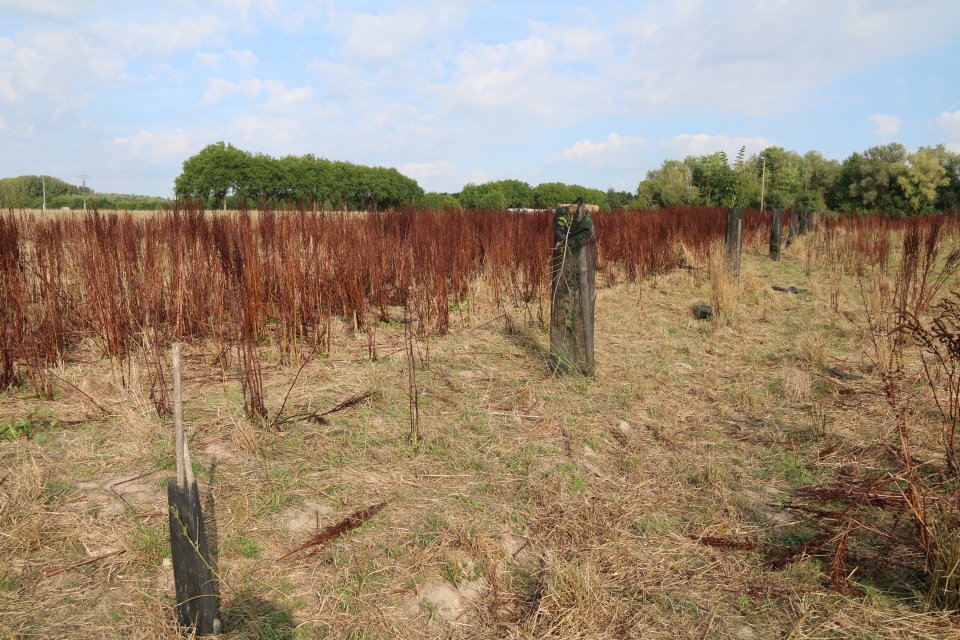
The farm covers approximately 80 hectares and consists of a group made up of five agricultural associates: two beekeepers, one hop grower, one arboriculturist and one market gardener. The associates have set up synergies between trees and all their organic farming systems : raising hens, cereals, berries, hedges, isolated trees, etc. The particularly permeable sandy-loam soil is very sensitive to erosion. Planting trees between fields creates favourable microclimates for maintaining humidity and restoring the degraded humus layer through the decomposition of organic matter (leaves, dead branches, etc.) by soil organisms.
- For adapting to climate change : plant trees and shrubs suited to the pedoclimatic context (chemical pollution, shelter from wind and storms, combatting drought, etc.) and combat soil erosion.
- For biodiversity : create ecological continuity between the Regional Natural Park and cereal fields, recreate the humus and surface soil layers.
- For the local area : contribute to the economic revenue of the local authority and use the wood in the firewood sector
Begun in 2020, the works consisted in :
- planting 286 timber trees (maple, oak, rowan, linden, wild cherry, elm…)
- planting 572 shrubs (birch, poplar, alder, willow…)
- setting up 1832 shrubs in hedges
The project, funded by the Nature 2050 programme spreads over 8 hectares, the 2976 trees and shrubs being arranged in rows between fields with occasional openings to enhance perspectives and show the tree to good effect.
BENEFITS REGARDING TARGETED ADAPTATION ISSUES
- Plant trees and shrubs suited to the pedoclimatic context (chemical pollution, shelter from wind and storms, combatting drought, etc.) and combat soil erosion.
OTHER BENEFITS
- Creating synergies between local natural and productive areas by means of ecological corridors between cultivated plots and the various forest massifs of the Haute Vallée de Chevreuse Regional Natural Park.
BENEFITS FOR BIODIVERSITY
- Regenerating a layer of humus favourable to crop growth and the microbial life of the soil.
- Recreating refuges for field birds and small raptors, which provide an effective pest bioregulation service, and creating ecological continuity between the groves and woods already present.
- Favouring the proliferation of insects, notably pollinisers which provide an essential ecosystem service for maintaining the productivity of farmland.
- Favouring the natural fertilisation of the soil and the infiltration of rainwater.
- Boosting the local forestry sector by enhancing future timber production.
- Mitigating climate change by creating carbon sinks.
- Improving the food sovereignty of the local area by combining several complementary agricultural activities and training workshops for the public.
- Developing climate change adaptation; improving risk management and resilience
- Increase infiltration / Water storage
- Reduce drought risk
- Reduce run-off
- Restoring ecosystems and their functions
TECHNICAL ASPECTS AND PROJECT DESIGN
- Planting before December : the resistance of saplings to increasingly frequent, long and intense droughts depends on the depth of their root system. Planting early gives the young plants time to connect with the water resources in the soil and thus confront the next drought.
- Sustainable water management : the associates of the Ferme des Clos water the trees from a tank (two waterings a fortnight apart) and use the mulching technique to maintain humidity at the foot of the trees. • Choosing indigenous tree species : the success rate varies considerably in function of the species. For example, larch and Paulownia did not give good results whereas Field Maple, Elm and Sweet Chestnut are thriving.
- Protecting saplings from deer : tall (2.10m-2.50m) and sufficiently robust (6-8 cm in diameter) chestnut stakes need to be set up that are capable of resisting bark-grazing pressure from deer. STAKEHOLDER COMMITMENT
- Activate the driving forces of the local area : the Ferme du Clos has implemented participative worksites with schools and the farm’s customers to carry out the agroecological works ques and raise public awareness.
- Create synergies between different production activities : a shepherd has his sheep graze the farm’s agroforestry.
MONITORING AND REPLICABILITY OF THE ACTION
- The monitoring-assessment indicators of the Nature 2050 programme can identify good practices in collaboration with the project leaders, help to adjust them if required and measure the long-term benefits of agroforestry techniques for the climate, biodiversity and the local area.
- The project leaders are not currently remunerated for the agroforestry developments despite the many benefits provided to the community. Payment systems for maintaining ecosystem services could make this type of project more attractive in the future
CDC Biodiversité Nature 2050 Programme : 16 650 €
Plus the cost of sustaining and monitoring the project until 2050, to be covered by the Ferme des Clos and CDC Biodiversité.
Nature 2050 – Programme & Fonds
nature2050@cdc-biodiversite.fr
- 2. Zero Hunger
- 13. Climate Action
- 15. Life On Land
